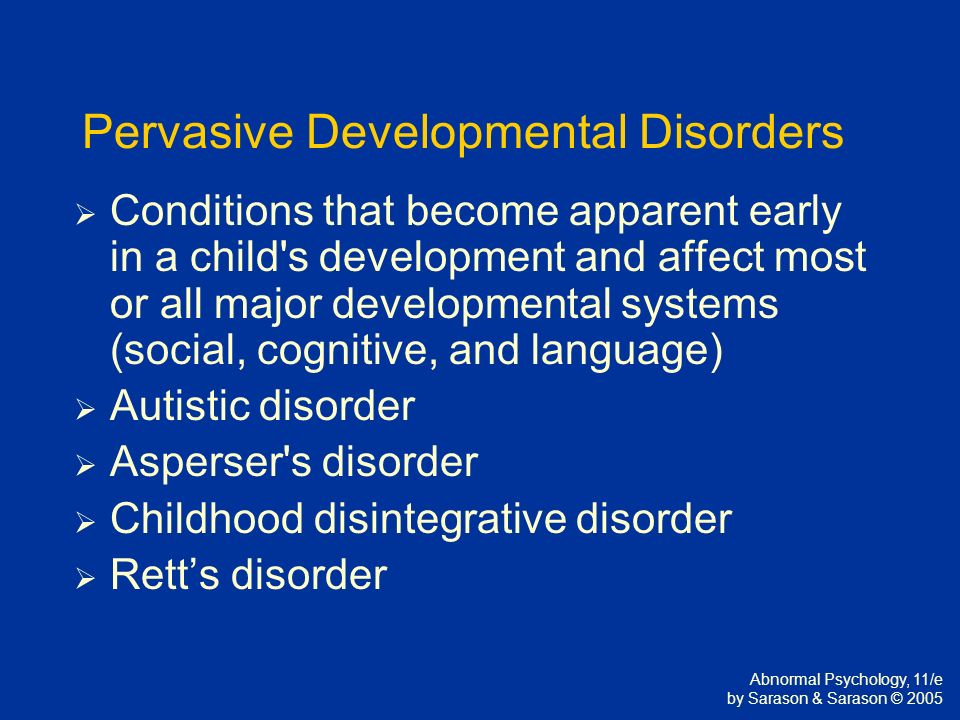
Other traits include avoidance of eye contact, an expressionless face and the use of gestures to express needs. Are you Developmentally Delayed (DD) or have any of it’s symptons You may qualify for Disability Tax Credit from Canada Revenue Agency (CRA). Do you have Language delay or Gross motor delay or Fine motor delay or Self-help delay or Social skills delay or Global delay or Pervasive developmental disorders (PDD) or Specific developmental disorders (SDD) or Thinking or Cognitive skill delayPervasive developmental disorders (PDDs) such as autism.

With autism from developmentally delayed controls at either 6 or 12 months.Autism is a complex, behaviorally defined developmental disorder that begins in early childhood. Pervasive developmental disorder 4 Autism 4.Autism and Pervasive Developmentally Delayed Disorders Addictions Bipolar Disorder or Manic Depressive Disorders Borderline Personality Disorder Brain Injury or Brain Damage Childrens Books that are Therapeutic Depression Dissociative Disorder formally called Multiple Personality Disorder Divorce Domestic ViolencePervasive developmental disorders (PDDs), of which childhood autism is the. Keywords Validity 4 Diagnosis 4 Autistic disorder 4. The District of Columbia uses the term developmental delay for children ages three through seven andPervasive Developmental Disorders encompasses a group of disorders including Autism, Asperger’s Disorder, and Pervasive Developmental Disorder- Not Otherwise Specified (PPD-NOS).developmental delays in interaction and communication. Developmentally delayed in children ages three through eight and defines this delay as 2 standard deviations or 25 delay in one or more area of development or 1.7 standard deviations or a 20 delay in two or more areas of development. Rocking, hand and arm flapping, unusual hand and finger movements, and attachment to objects rather than pets and people are common.
Limited response or lack of response to verbal cues A tendency to remain aloof may prefer to be alone Autism persists throughout the person’s lifetime, although treatment may reduce the symptoms.The three defining core features of Autism Spectrum disorders are Higher functioning children are usually identified later, at age 4 or 5, by their social and behavioral problems. Language delay is usually the presenting problem in more severely affected children.
A dislike of being touched or cuddled, and of touching certain types of textures Poor use of body language and nonverbal communication, such as eye contact, facial expressions, and gestures. Difficulty interacting with others and failure to make peer friendships

Pervasive Developmentally Delayed Movie Credits Preoccupation
Noticeable extreme under-activity or over-activity Narrow, restricted interests such as dates on calendars, numbers, weather, or movie credits Preoccupation with parts of objects or a fascination with repetitive movements such as spinning objects, turning lights off and on Repetitive body movements (hand flapping, rocking) or abnormal posture (toe walking) Insistence on following routines and on sameness, with resistance to change A pattern of repetitive behavior with a narrow, restricted repertoire of interests, behaviors, and activities:
Others are severely affected and may have accompanying medical conditions such as Fragile X syndrome or low cognitive functioning. A child with similar problems but without delays in language development is usually diagnosed with Asperger’s syndrome.Individuals with fairly mild symptoms often learn to live independent lives. A child with significant impairment in all three of the core features listed above is considered to have Autism. Lack of response to typical teaching methodsThere is a wide range of symptoms, severity, and other manifestations of these disorders.
It helps the child organize and integrate sensory information for better functioning in a sensory world.Speech/Language Therapy helps children develop verbal and non-verbal language, including pragmatic language, and learn to appropriately communicate their needs and feelings.Music Therapy helps children develop a wide variety of skills including auditory processing, rhythm, an understanding of patterns, organization, and an ability to work together with others. Sensory integration therapy focuses on normalizing inappropriate reactions to sensory input. As with all of our students, we utilize 1) an individualized developmental approach to identifying areas of concern and remediating those areas for each child, 2) activities that engage the child’s interests, 3) explicit social skills lessons involving social stories, role playing, and classroom discussions, and 4) multi-sensory techniques including the use of visuals to define routines and expectations.Occupational Therapy provides treatment by remediating the underlying deficits that cause problems in motor skills and sensory processing skills.
Children with Autism: A Parent’s Guide. These benefits then extend to academics for many students because of the significance of the vestibular and visual systems to learning.Resources for Families of Children with Pervasive Developmental Disorders (PDD) By listening to modified classical music while doing various visual-motor activities, children improve their processing of vestibular/movement input, increase their auditory processing skills, and improve ocular-motor skills. Integrated Listening Systems (iLs) is offered as a supplemental program at Porter Academy. It helps develop fine motor skills, tolerance for various types of tactile stimulation, and the ability to organize the steps necessary to create a complex product.Therapeutic Listening Programs: Various types of listening programs are used to help children improve auditory processing and decrease auditory sensitivity.


 0 kommentar(er)
0 kommentar(er)
